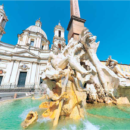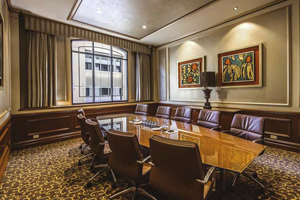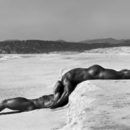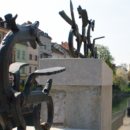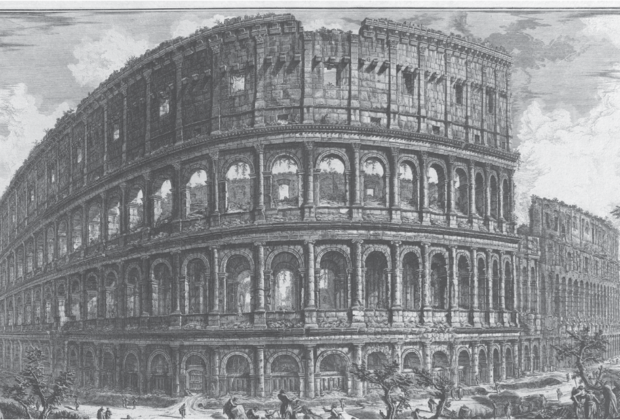
Roma, città scoperta
If I did not live enough in Rome (and I have certainly not yet surpassed my casual tourist calling), I will definitely have a hard time to really haul into its terrestrial or energetic catacombs and provide a detailed description of the city’s essence.
The first and most valuable impression links to its layers of overlapping history, divided and scoured by time, fully revealing themselves within the same scenery. It is extraordinary to observe the multitude of things that the conscience of history is able to acknowledge in just one vision! Before the engraver Piranesi (1720-1778),”the interpret and almost the inventor of Rome’s tragic beauty ” nobody has ever made so many images of Rome, with so many details and such a historical accuracy. In this cradle of civilization, one might say that contemporary art is suffocated and not able to live its ephemeral existence, undevoted yet, lying in the shadow of the Roman monumentality, to which we are also inclined nowadays, as if it were an eternal Mecca. But, we shall contradict our own fears as soon as we get to know Rome’s extraordinary museums and art galleries. Without any intrusion upon the architectonic harmony and the mysteries of the narrow streets placed between cold marble and stone buildings or, on the contrary, the bounteousness and the grandeur of the open spaces, the contemporary art spaces are perfectly integrated. They live simultaneously or they are placed right in the middle of a historical building. Although Rome is the city of Bernini’s sculptures, of Fontana’s or della Porta’s artesian wells or the memory of mthe equestrian and majestic emperors glorification, we shall often see contemporary sculptures in some original and I might say unexpected places, integrating perfectly with the eternal scenery. It is worth mentioning some of the contemporary artists part of the Roman urban show such as Igor Mitoraj (n. 1944, German of Polish origins), Fernando Botero (n, 1932, Columbia), Sandro Chia (n. 1946, representative of the Italian Transavangarde) etc.
Going back to the museums, Rome is hosting two of the most important institutions dedicated to contemporary art – MACRO and MAXXI. MACRO (Museo d’Arte Contemporanea Roma) has organized an architecture contest, won by the French Odile Decq and Benoît Cornette in 2001 and as a result the first venue of the museum is in one of the Peroni brewery’s buildings (via Nizza in the area of Salario). The construction works for the second headquarter, the MACRO Futuro, started in 2003 in a former slaughter house from Testaccio. The project of the French architects was completed in 2010 and in all these years, the museum hosted a series of important exhibitions. The permanent collection includes the works of some famous Italian artists like Forma 1 group (Carla Accardi, Antonio Sanfilippo, Achille Perilli, Piero Dorazio, Leoncillo and Ettore Colla), Arte Povera (Mario Ceroli and Pino Pascali), Scuola di Piazza del Popolo (Tano Festa, Mario Schifano, Titina Maselli and Mimmo Rotella). Other Italian artists who contribute to the collection are Giovanni Albanese, Andrea Aquilanti, Gianni Asdrubali, Domenico Bianchi, Bruno Ceccobelli, Sarah Ciracì, Enzo Cucchi, Fabrice de Nola, Gianni Dessì, Daniele Galliano, Federico Guida, Felice Levini, Fabio Mauri, Luigi Ontani, Cristiano Pintaldi, Piero Pizzi Cannella, Gioacchino Pontrelli, Sissi, Marco Tirelli.
MAXXI (Museo Nazionale delle Arti del XXI Secolo on via Guido Reni, in the area of Flaminio) stretches on a surface of 27.000 mp and was designed by the Iraki architect Zaha Hadid, after winning a contest in 1999. The opening took place in June 2010 and the museum has two sections – MAXXI arte and MAXXI archittetura. The permanent contemporary art collections, put together from direct purchases or donations and contain works by artists like Alighiero Boetti, William Kentridge, Kara Walker, Ed Ruscha, Gilbert & George, Gino De Dominicis, Michael Raedecker, Anish Kapoor, Gerhard Richter, Francesco Clemente, Lara Favaretto, Marlene Dumas, Maurizio Cattelan, Gabriele Basilico, Kiki Smith, Thomas Ruff, Luigi Ghirri, Manfredi Beninati, Vanessa Beecroft, Stefano Arienti, Francis Alys, Ugo Rondinone or Thomas Schutte.
Some of the important contemporary art galleries in Rome are represented by the Italian Gagosian gallery (via Francesco Crispi 16), Galleria Lorcan O’Neill (Via Orti D’Alibert, 1E), Galleria T293 (Via G.M. Crescimbeni, 10), L’Attico di Fabio Sargentini (via del Paradiso, 41), Magazzino (via dei Prefetti, 17), Monitor (via Sforza Cesarini, 43A) etc.
Rome is and shall always be a place of continuous searching: for the art or history lovers, for romantics or fine foods appassionatos. We can always go back. But, we are the ones who change – the Eternal City remains, apparently, the same.


